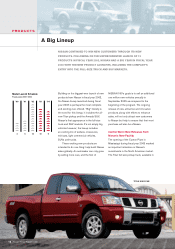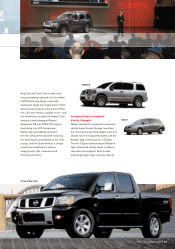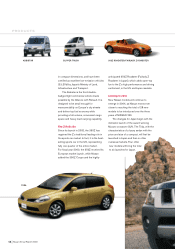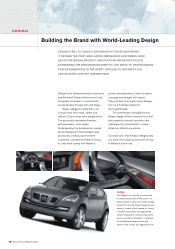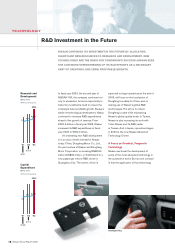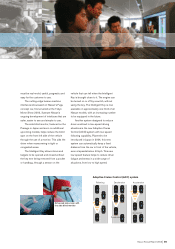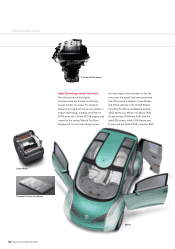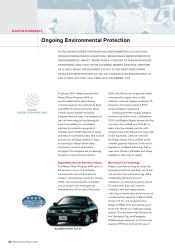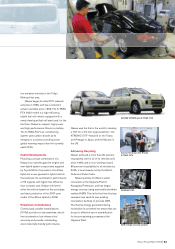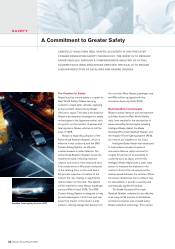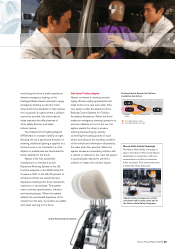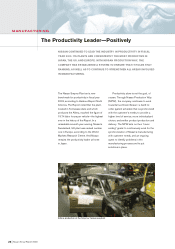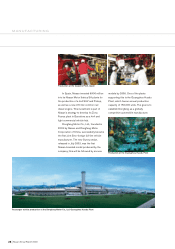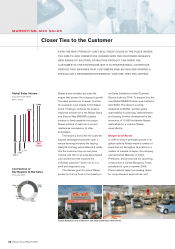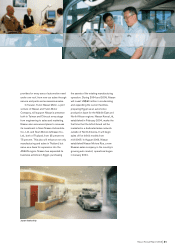Nissan 2004 Annual Report Download - page 24
Download and view the complete annual report
Please find page 24 of the 2004 Nissan annual report below. You can navigate through the pages in the report by either clicking on the pages listed below, or by using the keyword search tool below to find specific information within the annual report.
Nissan Annual Report 2003
22
In January 2001, Nissan launched the
Nissan Green Program 2005, an
environmental action plan outlining
concrete targets to be achieved by fiscal
year 2005. On the product side, these
include cleaner exhaust emissions,
increased fuel economy, the realization of
fuel cell technology and increasing the
level of recyclablity for new Nissan
vehicles. In production are goals to
eliminate direct landfill disposal of waste
and reduce incinerated waste. And in sales
and service, all Nissan dealers in Japan
are striving for Nissan Green Shop
certification. In short, all activities
throughout the company are increasingly
focused on environment protection.
Expanding the Low-Emission Lineup
The Nissan Green Program 2005 goal of
80 percent or more of all domestic
vehicles sold to be U-LEV (ultra-low
emission vehicles) was reached in January,
2003—two months ahead of schedule,
and far ahead of all other Japanese
manufacturers. At the end of fiscal year
2003, fully 90 percent of gasoline-fueled
vehicles sold in Japan were U-LEV
vehicles—cars with exhaust emissions 75
percent or more below Japan’s 2000
exhaust emission regulations.
Nissan pushed the exhaust emission
envelop even further when, in December
2003, the Bluebird Sylphy became the first
car ever to be certified as a SU-LEV—a
super ultra-low emission vehicle, with
exhaust levels some 50 percent lower than
U-LEV standards. Likewise in the US,
the Nissan Sentra CA is certified as the
cleanest gasoline-fueled car in the world.
Application of Nissan technology that is
even more efficient, affordable and widely
available in improving air quality.
Realizing FCV Technology
Nissan is actively working to realize the
full-scale production and daily use of fuel
cell vehicles. Fuel cell technology offers
outstanding efficiency and zero
emissions—an ideal future power source.
To realize their daily use, however,
creating a new fuel supply system,
collecting of market data and promotional
activities will be required. In March 2004,
Cosmo Oil Co., Ltd. leased the first
Nissan X-TRAIL FCV and started a joint
study with Nissan on a hydrogen supply
system. This movement was followed by
the Yokohama City and Kanagawa
Prefectural governments, in the first-ever
leasing of FCVs to promote the use of
IN THE NISSAN GREEN PROGRAM 2005 ENVIRONMENTAL ACTION PLAN,
NISSAN DEMONSTRATES SIGNIFICANT, MEASURABLE IMPROVEMENTS IN
ENVIRONMENTAL IMPACT. MORE THAN 90 PERCENT OF NISSAN GASOLINE
PASSENGER CARS SOLD IN THE JAPANESE MARKET ARE NOW CERTIFIED
AS U-LEVS, WHILE THE BLUEBIRD SYLPHY IS THE FIRST-EVER SUPER
ULTRA-LOW EMISSION VEHICLE (SU-LEV). NISSAN ALSO BEGAN SALES OF
THE X-TRAIL FCV FUEL CELL VEHICLE IN DECEMBER, 2003.
Ongoing Environmental Protection
ENVIRONMENT
BLUEBIRD SYLPHY SU-LEV


